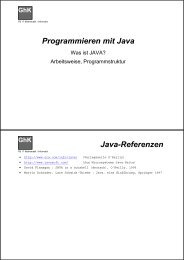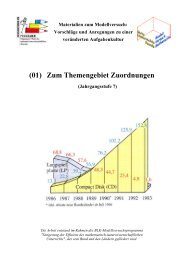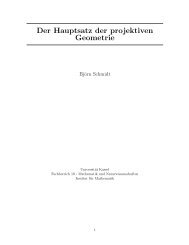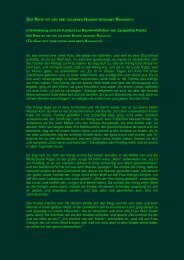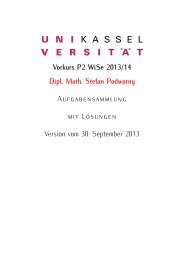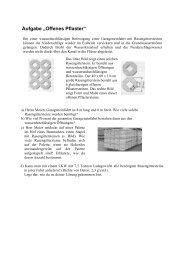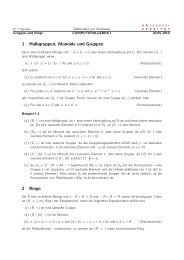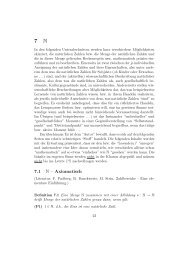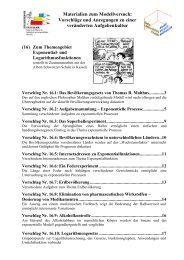Orthogonal Polynomials and Special Functions
Orthogonal Polynomials and Special Functions
Orthogonal Polynomials and Special Functions
Create successful ePaper yourself
Turn your PDF publications into a flip-book with our unique Google optimized e-Paper software.
October 1998 <strong>Orthogonal</strong> <strong>Polynomials</strong> <strong>and</strong> <strong>Special</strong> <strong>Functions</strong> Newsletter 16<br />
cial functions. Typical examples of such constructions are<br />
the Clebsch-Gordan coefficients <strong>and</strong> the Racah coefficients<br />
connecting different orthonormal bases in tensor product<br />
representations.<br />
The interaction between group representations <strong>and</strong> special<br />
functions can be approached from at least three different<br />
points of view:<br />
(i) Start with a special group. Consider different kinds of<br />
special functions occurring on it. This usually gives<br />
rise to relationships between these special functions.<br />
For instance, Jacobi polynomials <strong>and</strong> Hahn polynomials<br />
live on SU(2) as matrix elements of irreps <strong>and</strong> as<br />
Clebsch-Gordan coefficients, respectively. As a consequence,<br />
products of Hahn polynomials occur as expansion<br />
coefficients in the expansion of a product of<br />
Jacobi polynomials in terms of other Jacobi polynomials;<br />
see §8.3.6 of the volumes under review.<br />
(ii) Start with a special function. Find interpretations for<br />
it of various kinds on several groups. Then try to find<br />
a conceptual explanation which links these interpretations<br />
together. For instance, Krawtchouk polynomials<br />
live on SU(2), again as matrix elements (see §6.8.1)<br />
<strong>and</strong> on wreath products of symmetric groups as spherical<br />
functions (see §13.1.4). A conceptual link between<br />
the two interpretations was given in Koornwinder [11].<br />
(iii) Start with a general structure in the context of group<br />
representations. Find properties involving special<br />
functions which fit into this structure. For instance,<br />
consider (zonal) spherical functions on Gelf<strong>and</strong> pairs;<br />
see §17.2. Spherical functions satisfy many nice properties.<br />
Whenever one has an interpretation of a special<br />
function as a spherical function, then one should<br />
try to rephrase these nice properties in terms of the<br />
special function.<br />
In our opinion, the third approach should get the most emphasis.<br />
Of course, the cases where elegance in group representations<br />
<strong>and</strong> in special functions happily meet do not<br />
exhaust everything of interest in special functions. Many<br />
important formulas for special functions may be derived<br />
in a shorter or longer, but not very illuminating, way from<br />
the group interpretation, but may possibly have a shorter<br />
derivation just from the analytic definition of the special<br />
function. We think that for these cases one should be pragmatic<br />
<strong>and</strong> give the shortest derivation.<br />
Let us now discuss the volumes under review in more<br />
detail. The authors have succeeded in writing an encyclopedic<br />
treatise containing a wealth of identities on special<br />
functions. The main examples fit into the methods<br />
sketched above. But there is also a chapter in volume 3 on<br />
the quantum SU(2) group, or better on the quantized universal<br />
enveloping algebra Uq(sl(2, C)). There is also some<br />
information on the symmetric group, on groups over finite<br />
fields <strong>and</strong> over the p-adics, on affine Lie algebras <strong>and</strong> on<br />
modular forms.<br />
A typical chapter starts with a discussion of the Lie<br />
group <strong>and</strong> Lie algebra involved, while introducing suitable<br />
bases for the Lie algebra <strong>and</strong> corresponding one-parameter<br />
subgroups of the Lie group. This then gives suitable coordinates<br />
on the Lie group like the Euler angles on SU(2).<br />
Next the representation theory is discussed: constructions,<br />
irreducibility <strong>and</strong> intertwiners. The special functions are<br />
then brought into play, <strong>and</strong> usually the remainder of such<br />
a chapter is on the special functions involved. Then the<br />
role of the group is pushed into the background <strong>and</strong> the<br />
special functions take a predominant role. Some special<br />
function identities derived do not involve any group theoretic<br />
considerations.<br />
As mentioned previously, the three-volume set is the successor<br />
of Vilenkin’s 1965 book [19], so a comparison is in<br />
order. Vilenkin’s book [19] is about the size of one of these<br />
volumes. The subject of the chapters of volume 1 overlaps<br />
with Chapters 1–8 of [19], although the material is<br />
exp<strong>and</strong>ed, which is particularly true for Chapter 8 in volume<br />
1 on Clebsch-Gordan <strong>and</strong> Racah coefficients, one of<br />
the fields of expertise of the second author [9] (see also<br />
Chapter 18 in volume 3). Also new compared to [19] is<br />
the consideration of the transition matrices for irreps of<br />
SL(2, R) in Chapter 7. Volume 2 has some overlap, but<br />
much less so, with Chapters 9–11 of [19]. So the new material<br />
is mainly contained in volumes 2 <strong>and</strong> 3.<br />
Chapters 13, 14 <strong>and</strong> 19 deviate from the others in the<br />
sense that the groups considered are not Lie groups. In<br />
Chapter 13 discrete groups are considered. First there<br />
are two examples of finite groups: the symmetric group<br />
(but not any other Weyl group) related to Hahn <strong>and</strong><br />
Krawtchouk polynomials <strong>and</strong> finite groups of Lie type related<br />
to basic (or q-)hypergeometric polynomials. It is a<br />
pity that the authors’ notation for basic hypergeometric series<br />
has a meaning which is different from the usual one; see<br />
the st<strong>and</strong>ard reference by Gasper <strong>and</strong> Rahman [5]. Also in<br />
Chapter 13 there is a section on the p-adic number field <strong>and</strong><br />
related Γ <strong>and</strong> B-functions <strong>and</strong> on SL2 over the p-adics, but<br />
not on the spherical functions on a group of p-adic type; see<br />
Macdonald [12]. Chapter 14 contains a discussion of the<br />
quantum SL(2, C) group <strong>and</strong> its relation to basic hypergeometric<br />
orthogonal polynomials. The chapter does not<br />
treat the important interpretation of Askey-Wilson polynomials<br />
as spherical functions or matrix elements on the<br />
quantum SL(2, C) group; see for instance Koelink’s survey<br />
lectures [10]. Finally, Chapter 19 contains an introduction<br />
to affine Lie algebras <strong>and</strong> modular forms.<br />
The present book does not always follow a clear philosophy<br />
about what should be obtained from the group context<br />
<strong>and</strong> what can be derived as well analytically (see our point<br />
of view above). For example, the second order differential<br />
equation for the Jacobi polynomials is first derived in §6.7.5<br />
by composition of two ladder operators acting on matrix<br />
elements of irreps of SU(2). These ladder operator actions



